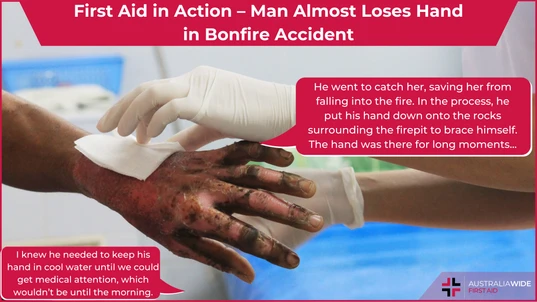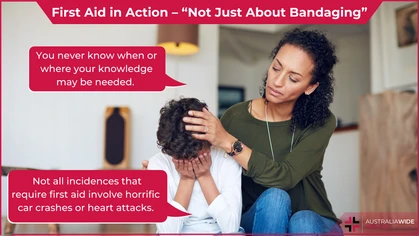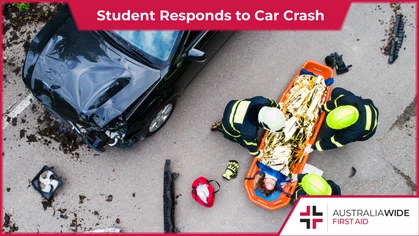First Aid in Action – Man Almost Loses Hand in Bonfire Accident

First aid in action
 First aid techniques and skills have certainly evolved over the past few decades. Initial care for burns, however, is something that is a bit more universal.
Here we take a look at the story of Heather and Alf who faced the horrors of burns to the entire underside of a hand.
Heather's calm and quick actions minimised the damage caused by the burn, and likely saved Alf's hand from significant damage.
First aid techniques and skills have certainly evolved over the past few decades. Initial care for burns, however, is something that is a bit more universal.
Here we take a look at the story of Heather and Alf who faced the horrors of burns to the entire underside of a hand.
Heather's calm and quick actions minimised the damage caused by the burn, and likely saved Alf's hand from significant damage.
Bonfire Burns
We were at a bonfire gathering of friends in semi-rural New South Wales. One lady slipped near the fire. Alf went to catch her, saving her from falling into the fire. In the process, he put his hand down onto the rocks surrounding the firepit to brace himself. The hand was there for long moments while both Alf and the woman regained their balance and were able to stand. Realising what had happened, we bolted for a bucket of cool water to dip his hand in. He was in a lot of pain. He couldn’t take it out of the bucket without almost passing out from the pain. I knew he needed to keep his hand in cool water until we could get medical attention, which wouldn’t be until the morning. We kept topping up the cool water, swapping out the water that was warming up. We also kept the water moving so it was never settling against his skin. We kept up this process throughout the entire night. In the morning we drove to a doctor’s office and the doctor commented how the quick action of getting the hand into the bucket of cool water and keeping it there had likely saved his fingers. The skin had blistered but keeping it in the water overnight had minimised the damage. After a week or so, they determined that there was minimal to no nerve damage. A few weeks of dressings and allowing the skin to heal, and his hand is perfectly fine today! Note though that this was in the early 1990s, so medical advice is of course slightly different today. If it had happened now, we would have called for an ambulance that night.First Aid for Burns
In this instance, Heather did the right thing given their location and resources. Removing the source of the burn is the first step. If there is fire on the person, make sure to put it out by using a fire blanket or rolling them on the ground. If electricity is involved, turn off the source. If it is a chemical burn, remove affected clothing. The second step is to run cool water over the area for at least 20 minutes. This removed the heat from the skin and tissues, preventing the burn from going deeper. It also provides a level of pain relief. If removing the burn from the water results in significant pain, keep it under the water for longer. Take short breaks periodically to check the condition of the burn and the person. Avoid applying ice or cold packs to the area, as they can inadvertently cause further damage to nerves and tissues. Cool water is the best option. In this instance, Heather had decided that it was unreasonable to keep a tap running for as long as it would take to cool the entire hand. She improvised by getting a nearby bucket that was large enough to fit his entire hand and filled it with cool water. She knew to keep the water moving, so that the water closest to the skin never got too hot. Periodically refreshing the water kept it cool enough to be effective. Once the burn has lost its heat, cover it with a light, non-stick bandage. This is to reduce the risk of further injury to the area, particularly infection. Be careful to not use any material that my leave behind fluff or fibres – cling wrap is a perfect material to use. Never burst any blisters, and never apply any creams or oils unless directed by a medical professional. Incorrect use of lotions, creams, and oils can lock in heat, causing further damage. Call an ambulance or go straight to the emergency department if the any of the following has occurred:- Burn is deep — nerves may be damaged if the victim is feeling no pain
- Burn is larger than a 20 cent piece
- Burns involve the genitals, airways, face, or hands
- Skin is dry and leathery where burnt
- Skin has white, black or brown patches
- Burns involve electricity or chemicals
- Victim is struggling to breathe
First Aid Training
Keeping your first aid skills and knowledge up to date ensures you are best prepared for unexpected incidences like the one above. As first aid knowledge and techniques are being constantly improved upon, it’s important to take refresher courses at the recommended intervals. You never know when you might need to use first aid techniques. It is rarely in a catastrophic emergency, and far more likely to occur at home. Knowing you can help your family and friends is priceless. We have training locations in every state, capital city, and major town throughout Australia. To find and enrol in a first aid course near you, simply follow the prompts.
Originally published at
https://www.australiawidefirstaid.com.au/resources/man-almost-loses-hand-in-bonfire-accident
as part of the Australia Wide First Aid Articles Library

